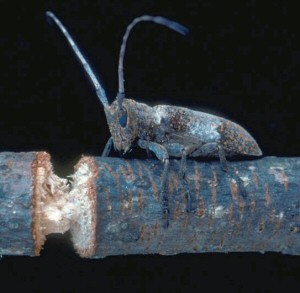Twig Girdler
 Scientific Name
Scientific Name
Oncideres cingulata
Host
Twig girdlers are commonly found on pecan, hickory, persimmon, and elm. They also attach oaks, honeylocust, hackberry, poplar, dogwood, sourwood, and various fruit trees.
Symptoms
It is not uncommon to see the ground under infested trees almost covered with twigs that have been cut off. This affects the beauty and aesthetic quality of ornamental plantings. The fruiting area of heavily infested pecan trees is often greatly reduced, resulting in low nut yields the following year and sometimes longer. This type of injury causes the development of many offshoots that adversely affect the symmetry of the tree. Pecan nurseries located close to heavily infested woodlots occasionally suffer considerable loss from girdled seedlings.. Repeated girdling of terminals causes forks, crooks, and other stem deformities in young timber plantations as well as in natural reproduction.
Life Cycle
Adults emerge from late August to early October. They feed on tender bark near branch ends and mate before laying eggs and girdling twigs. Twigs are girdled because the larvae are unable to survive in living twigs. The girdling extends through the bark and well into the wood in a complete circle around the stem and leaves only a thin column of the center wood attached, which breaks easily. Twigs from 1/4 to 1/2 inch in diameter are most commonly girdled. Eggs are laid during or after the cutting process, but never before the beetle makes part of the cut. Eggs are inserted singly beneath the bark or slightly into the wood, usually near a bud scar or adjacent to a side shoot. The number of eggs per twig normally ranges from 3 to 8 but may range up to 40. Adults live 6 to 10 weeks. Each female deposits 50 to 200 eggs which hatch in about 3 weeks. The small larvae overwinter in the dead twig either in the tree or on the ground. Larvae grow rapidly in the spring and tunnel toward the severed end of the twig, feeding only on the woody portion and leaving the bark intact. The mature larva closes off the gallery with shredded fibers to form a pupation chamber. Pupation occurs during August and September and lasts 12 to 14 days. The adult chews a circular hole in the bark to emerge. There is one generation per year.
Description
The adults are typical longhorned beetles that range from 1/2 to 5/8 inch long. They are grayish brown in color with a broad, ashy-gray band across the middle of the wing covers. The antennae are at least as long as the body. The eggs are white, elongate oval, and about 3/32 inch in length. The larvae are whitish, cylindrical, legless grubs that reach about 3/4 inch in length at maturity.
Control
Please contact your local county extension office for current information.
